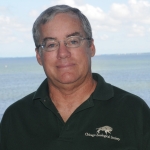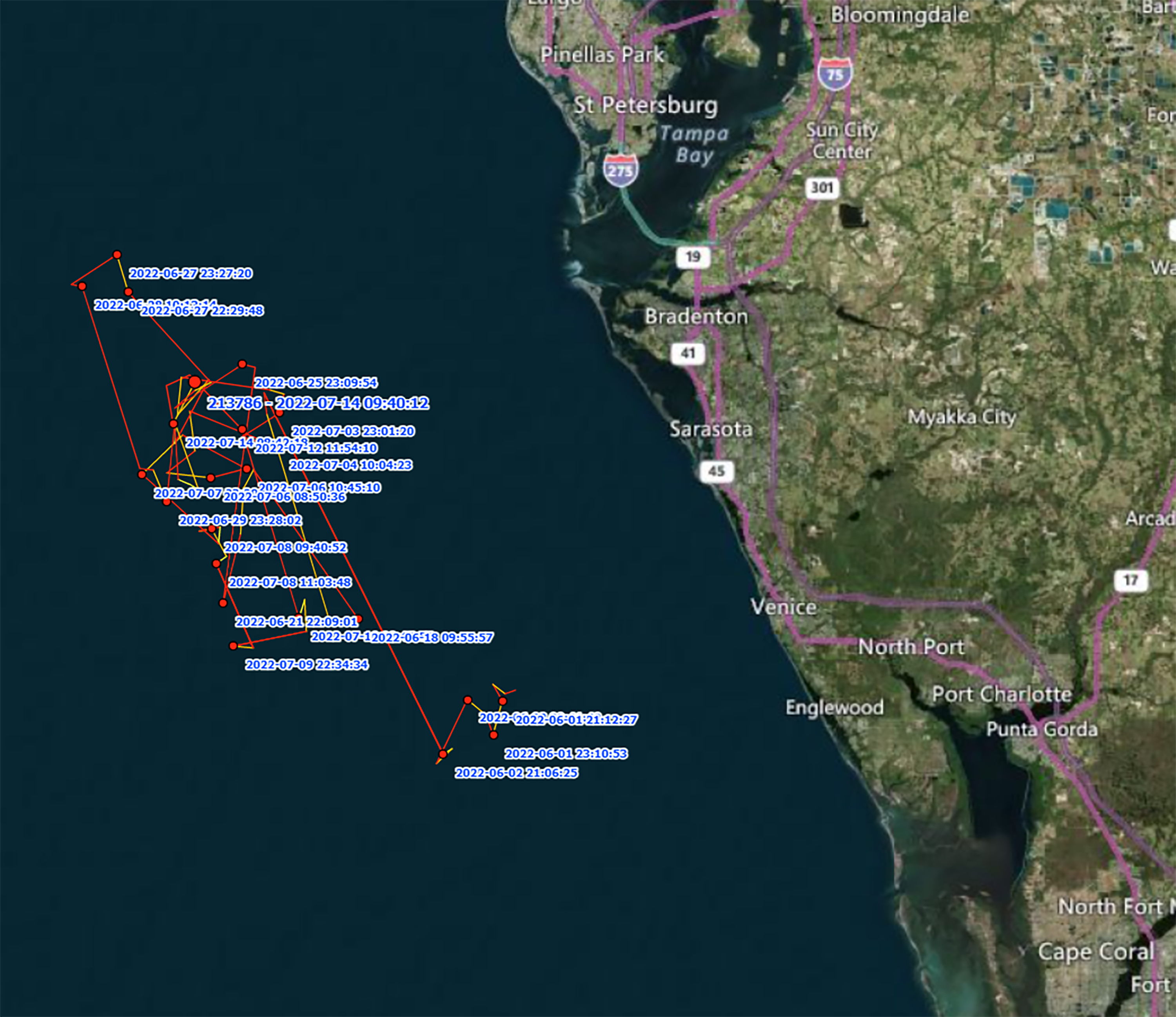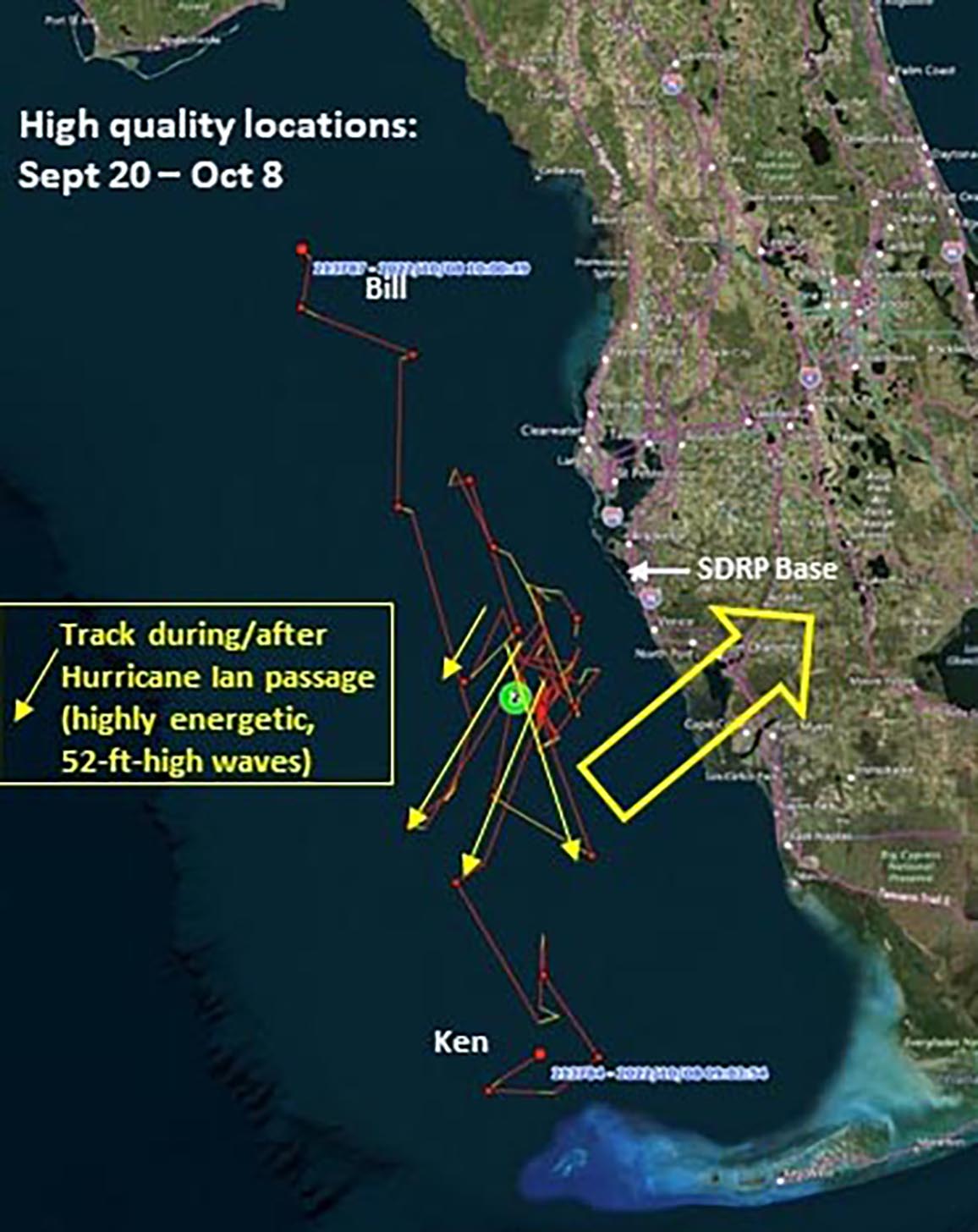We’ve got some exciting news to share about our ongoing efforts to conduct health assessments of offshore dolphins: In September, we were able to conduct assessments and tag four dolphins over the West Florida Shelf. The SDRP is leading this project, which involves a multi-institution team funded by the Florida RESTORE Act Centers of Excellence Program, through the Florida Institute of Oceanography.
The project involves hoop-netting individual dolphins (focusing primarily on bottlenose or Atlantic spotted) up to 50 miles offshore, over the West Florida Shelf, performing a health assessment, and tagging them for monitoring movements and dive patterns. We have now completed the first two of four planned field sessions.
During the first session, we caught, sampled, and tagged an adult female Atlantic spotted dolphin, nicknamed Eugenie Clark, after the founder of Mote Marine Laboratory, where the SDRP started in 1970.

This map shows dolphin Eugenie Clark’s movements after tagging.
During her health assessment and lung-function tests, she was given both a satellite-linked time, depth and location tag and a short-term digital archival tag, known as a DTAG. The satellite-linked tag, tracked for 106 days until Sept. 14, showed that she ranged 25-50 miles offshore from Tampa Bay to Englewood, Florida, and dove as deep as 147 feet for up to 4-5 minutes.
Building on our success in June, the team returned to the field September 19-23, and tagged four more dolphins:
- Two bottlenose dolphins — nicknamed Sylvia, after Her Deepness, ocean conservationist Sylvia Earle, and Ken, after Ken Norris, who was one of the founders of the field of marine mammal science and instrumental in developing the federal Marine Mammal Protection Act;
- One rough-toothed dolphin — nicknamed Sam, after Sam Houston Ridgway, who is considered the founder of marine mammal medicine and who founded the National Marine Mammal Foundation;
- And one Atlantic spotted dolphin — nicknamed Bill, after Bill Perrin, who was a pioneer in dolphin taxonomy, life history, population ecology, conservation and behavior, and another of the forces behind the Marine Mammal Protection Act.

Rough-toothed dolphin Sam upon release.
The animals were caught 20-41 nautical miles offshore of the Sarasota area. All but Sam received both a satellite-linked tag and a DTAG. The DTAG remained on the large adult male bottlenose dolphin Ken for the entire programmed period, and showed him to begin diving to the seafloor and feeding within 5 minutes of release.
Initial findings show all but Sam diving to the seafloor — he remained at depths less than 52 feet.
The dolphin tags transmitted while Hurricane Ian moved through the area and came ashore south of where the dolphins had been tagged.
The image to the right shows their locations during Sept. 20-Oct. 8.
The dolphins, from north to south are 213785 (rough-toothed dolphin Sam), 213783 (bottlenose dolphin Sylvia), 213787 (Atlantic spotted dolphin Bill) and 213784 (bottlenose dolphin Ken).
The large open yellow arrow shows Hurricane Ian’s path on Sept. 28. The smaller yellow arrows show the approximate tracks of the dolphins during and immediately after passage of the storm, suggesting the dolphins were moving with the wind-driven following seas.

The overarching goal of this research is to provide requisite information for species conservation and management and the project is addressing critical information gaps for the two species of cetaceans that regularly inhabit Florida’s Gulf coastal and shelf waters. Our specific objectives include:
- Improving understanding of dolphin stock structure and habitat use through tagging, tracking, and genetic sampling.
- Establishing baseline data on environmental contaminant concentrations in dolphin tissues.
- Obtaining baseline dolphin health data.
- Evaluating potential relationships between lung disease and respiration and diving patterns.
- Investigating feeding patterns through stable isotope and fatty acid analyses.
- Maintaining and expanding the long-term Gulf of Mexico Dolphin Identification System (GoMDIS).
We are in the process of analyzing samples and movement and dive data from all five dolphins tagged for this project. The lead organizations on the project, the Chicago Zoological Society and Mote Marine Laboratory, greatly appreciate the involvement of a number of programs in the fieldwork, including the National Marine Mammal Foundation Board of Directors’ Grants Program for supporting involvement of their veterinarians, the University of Florida College of Veterinary Medicine, and Woods Hole Oceanographic Institution. The next field session is scheduled for May 2023.
Randy Wells




